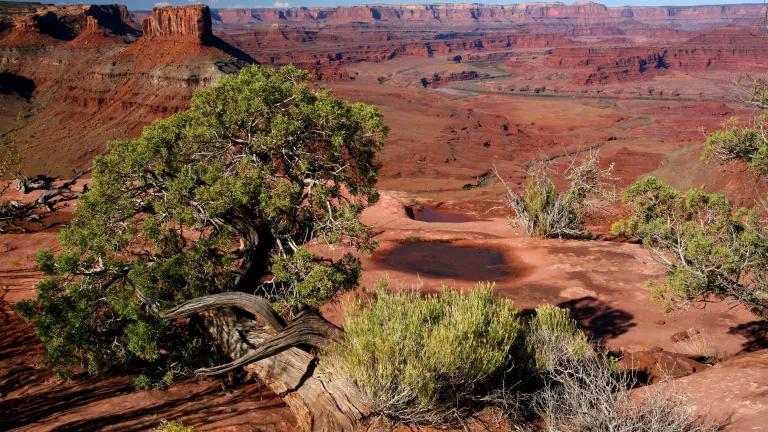
As part of his January 27 Executive Order on Tackling the Climate Crisis, President Biden directed the Interior Department to outline steps to achieve the President’s commitment to conserve at least 30% of our lands, waters and oceans by the year 2030. America’s Red Rock Wilderness Act can provide a critical piece. A report released today by NRDC and its partners in the Utah Wilderness Coalition shows how
What is 30x30?
To stop the loss of nature and address the climate crisis, scientists say we need to protect 30% of the earth’s lands and waters by 2030, with the ultimate goal of keeping 50% natural. In the United States, only 12% of land is currently protected. Many of these lands exist in isolated fragments, surrounded by human development.
To save 30x30, we need to take action that prevents mass extinction, mitigates climate change while also bolstering resistance to it—all at the same time. Giving more to nature will preserve the integrity of ecosystems on which we all depend. It will provide safe havens to help wildlife adapt to climate change, as well as sustain natural systems that store carbon, such as forests, wetlands and grasslands. Recent analysis shows the vital role that Utah’s red rock canyon country can play.
What is America’s Red Rock Wilderness Act?
The Red Rocks Act proposes to protect almost 9 million acres of wilderness quality land in Utah. These lands represent some our last wild places from the canyons of the Escalante River to the plateaus of the Grand Staircase. Many of these lands are sacred to the Native Americans who have inhabited them for centuries.
Why does America’s Red Rock Wilderness Act matter to 30x30?
The 30x30 agenda is not just about how much we protect, but where we protect it. America’s Red Rock Wilderness Act increases “landscape connectivity” in the region, providing a critical link in a chain of predominantly natural landscapes stretching along the “Spine of the Continent” from Mexico to the Arctic, thus enhancing ecosystem health throughout the region.
Our existing national parks, wildlife refuges and wilderness areas sit as fragments of land that are largely isolated from each other. The sad reality is that these isolated fragments are simply not large enough to sustain a healthy diversity of species and habitats. And climate change is making this situation worse.

Wildlife corridors benefitting from passage of America’s Red Rock Wilderness Act
The lands that would be protected by the Red Rocks Act provide critical lifelines for wildlife as they move across the landscape two and from some of America’s most iconic lands—including the Grand Canyon, Canyonlands and Yellowstone.
Such connectivity isn’t just important for wildlife, it is critical for humans. We are fragmenting our land and waters and the natural systems upon which all life depends. We can restore some of what we have already fragmented, but that’s a lot harder than protecting the unified landscapes we have left. Other than Alaska, the lands protected by America’s Redrock Wilderness Act represent the largest possibility of doing so in the United States. We owe it to our children to preserve these lands for tomorrow, rather than trashing them for short-term profits today.
For 30 years, I have been fighting project by project—oil and gas lease by lease, drilling permit by drilling permit, to protect Utah’s irreplaceable wilderness lands. It is more efficient for everyone to approach the landscape strategically and yields far greater conservation benefits. That is what the Biden Administration is doing by demonstrating its commitment to 30x30. And America’s Red Rock Wilderness Act provides a holistic and concrete step toward reaching that goal.
How we work is even more important than what we work on. Many of the lands in the Red Rocks Act are ancestral lands of the Indian Nations in the region. We must include them in designing the solutions to the climate and extinction crises we face together. A commitment to tribal co-management of Bears Ears National Monument is a good start, but we must do more.
As humans, we are one piece in the inter-connected web of life. Yet, we have a disproportionate power to affect that web. May we strengthen rather than destroy it.


